Welcome to “The Basics of Gardening: Your Green Thumb Starter Guide.” In this comprehensive guide, we’re diving headfirst into the world of gardening, equipping you with the fundamental knowledge you need to nurture your plants, cultivate your green haven, and embrace the joys of gardening. Let’s embark on this journey of growth and transformation together.
Selecting Garden Space
Selecting Your Garden SpaceThe first step is crucial: selecting the perfect space for your garden to thrive. Let’s dive into the art of finding the ideal location where sunlight, soil, and space harmonize to create a nurturing haven for your plants.
Finding the Perfect Spot: Sunlight, Soil, & Space

Your gardening adventure begins with selecting the ideal location for your plants to thrive. A vibrant garden bathed in sunlight, flourishing in rich soil, and spacious enough for your plants to spread their roots. When seeking the perfect spot, remember that different plants have varying sunlight requirements. Observe your yard throughout the day to identify areas with full sun, partial sun, or shade. This crucial step sets the foundation for a thriving garden.
Equally important is the soil quality. Understanding your soil’s composition – whether it’s clay, sandy, or loamy – empowers you to make informed decisions about plant selection and amending the soil for optimal growth. Remember, a soil test can provide invaluable insights into the nutrients your soil might lack, allowing you to amend it effectively.
Consider the available space as well. Depending on the size of your garden, you can opt for in-ground beds or raised beds. Take note of potential obstructions like overhanging trees or structures that might cast shadows over your garden area. Your garden’s success depends on selecting the right spot that aligns with your chosen plants’ needs.
Container Gardening: A Solution for Small Spaces
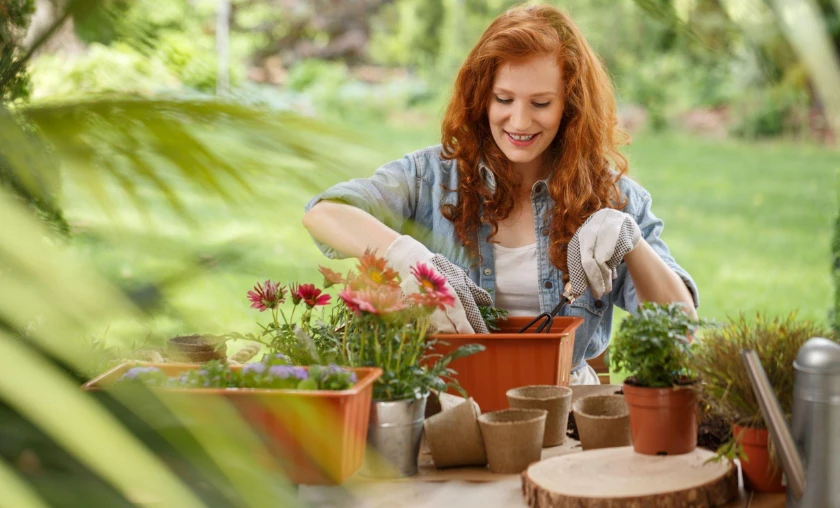
Need a sprawling yard? Fear not – container gardening is here to save the day. Containers offer a versatile and creative solution if space is at a premium. Whether you have a balcony, patio, or even just a windowsill, you can transform these spaces into lush, thriving gardens.
Select containers that are appropriate for the plants you wish to grow, ensuring they have proper drainage to prevent waterlogging. This method allows you to control the soil quality and sunlight exposure more effectively, giving you the freedom to grow a diverse array of plants, from ornamental flowers to herbs and vegetables.
Container gardening opens up a world of possibilities for urban dwellers and those with limited outdoor space. With the right care and attention, your containers can burst with life, providing you with the satisfaction of nurturing plants regardless of your spatial constraints.
Soil & Amendments
Understanding Soil & AmendmentsAs we dig deeper into the world of gardening, we come to a fundamental aspect that forms the bedrock of your garden’s success: understanding soil and amendments. Just as a strong foundation is essential for a building, healthy soil lays the groundwork for thriving plants. Let’s explore the intricate dance between soil types, nutrients, and the art of nurturing the very essence of your garden.
Digging Deeper: Types of Soil & Soil Preparation
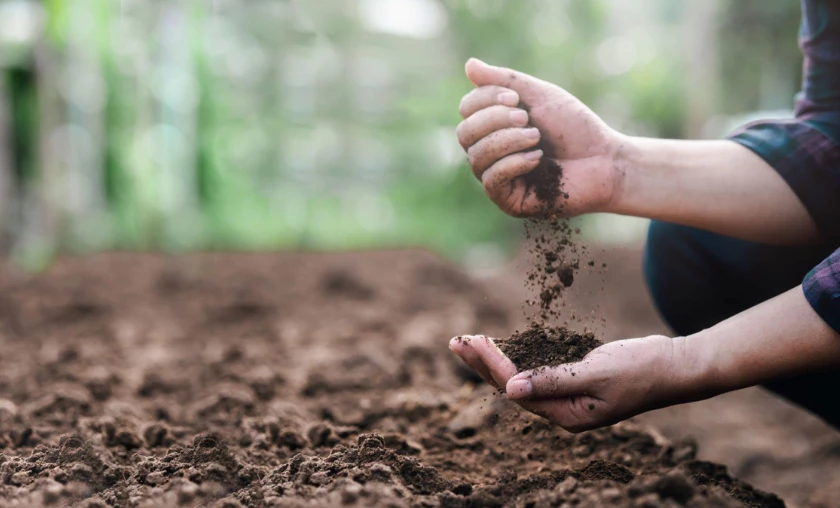
Just as a sturdy foundation is essential for a building, nutrient-rich soil is the cornerstone of a bountiful garden. Soil isn’t just dirt; it’s a complex ecosystem with minerals, organic matter, and microorganisms that work harmoniously to support plant growth. Before you start planting, it’s crucial to identify the type of soil you have.
Is your soil clay-heavy, sandy, or loamy? Each type has distinct characteristics that influence water retention, drainage, and nutrient availability. Understanding your soil type helps you tailor your gardening practices accordingly. To gain insight, perform a simple soil test or consult with local gardening experts who can guide you on improving soil quality.
Soil preparation involves more than just digging a hole and planting a seed. Begin by clearing the area of weeds, rocks, and debris. Then, consider techniques like tilling or aerating to improve soil structure and porosity. Adding organic matter, such as compost or well-rotted manure, enriches the soil with nutrients and enhances its water-holding capacity. A well-prepared soil bed provides your plants with a nurturing environment for healthy growth.
Fertilizers & Compost: Nourishing Your Garden’s Foundation

Think of fertilizers and compost as your garden’s gourmet meals – they provide the essential nutrients your plants crave. Fertilizers supply plants with nitrogen, phosphorus, and potassium, known as N-P-K, which are vital for growth, flowering, and fruiting. However, understanding the right balance and application methods is key to avoiding over-fertilization.
Compost, on the other hand, is the gold standard of organic matter. It’s a rich source of nutrients, enhances soil structure, improves water retention, and supports beneficial microorganisms. Creating your own compost pile from kitchen scraps, yard waste, and organic matter is environmentally friendly and an excellent way to recycle nutrients back into your garden.
Remember, moderation is key when it comes to fertilizing. Too much can lead to nutrient imbalances & environmental harm. Strive for a balanced approach by combining both organic and slow-release synthetic fertilizers, allowing your plants to thrive without causing harm to the ecosystem.
Choosing the Plants
Choosing the Right PlantsChoosing the right plants to bring your garden dreams to life. Whether you’re envisioning a colorful tapestry of blooms or a bountiful harvest of vegetables, the plants you select will shape the character of your garden. Let’s embark on a journey of discovery as we delve into the art of plant selection tailored to your aspirations and your environment.
Blooms or Veggies: Picking Plants Aligned with Your Goals

Your garden is your canvas, and the plants you choose are the colors you paint with. As you embark on this journey, ask yourself: Do you envision a kaleidoscope of vibrant flowers, or are you excited about harvesting your own organic vegetables? Determining your gardening goals is the first step in narrowing down your plant choices.
If you’re drawn to the beauty of blossoms, explore the variety of flowering plants, shrubs, & trees. From delicate perennials to bold annuals, blooms offer endless possibilities to infuse your garden with color, texture, and fragrance.
On the other hand, if the idea of growing your own food appeals to you, vegetable gardening might be your path. Imagine stepping into your backyard to pluck fresh tomatoes, crisp lettuce, and fragrant herbs. Not only does this provide a rewarding culinary experience, but it also connects you to the earth and the cycles of growth.
Hardiness Zones: Matching Plants to Your Climate

Just as humans have preferred climates, plants have their own preferences. Enter hardiness zones – a guide to which plants thrive in specific regions. Understanding your hardiness zone is like speaking the secret language of plants; it helps you select varieties that are tailored to your climate’s temperature and weather patterns.
The United States, for example, is divided into 11 hardiness zones, each characterized by a range of minimum winter temperatures. By identifying your zone, you can confidently choose plants that are more likely to thrive in your environment. This reduces the risk of frost damage and ensures your garden remains vibrant and resilient.
When selecting plants, be mindful of their sunlight requirements, water needs, and soil preferences. Some plants prefer full sun, while others thrive in partial shade. Additionally, water-wise gardening involves choosing plants that can tolerate your local rainfall patterns, reducing the need for excessive watering.
Techniques for Success
Planting Techniques for SuccessWe’re about to plunge our hands into the soil and explore the art of planting techniques. From delicate seeds to resilient young plants, the way we plant sets the stage for a garden that thrives. Join me as we uncover the secrets of planting success and nurturing life from the tiniest beginnings to magnificent growth.
From Seed to Sprout: Planting Seeds with Care

Planting seeds is like sowing the seeds of your dreams. It’s a practice that requires patience, attention, and a touch of finesse. Before you begin, familiarize yourself with the seed’s specific needs. Some seeds flourish when directly sown into the soil, while others benefit from an indoor head start.
When planting seeds, ensure the soil is well-prepared, loose, and free from debris. Follow the recommended planting depth & spacing for each type of seed, as overcrowding can hinder growth. Gently cover the seeds with soil and water them in, providing the moisture needed to kickstart germination.
Consistent moisture and the right amount of sunlight are key to successful germination. Be attentive as your tiny seeds evolve into delicate sprouts, and celebrate each new leaf as a testament to your nurturing touch.
Transplanting & Bedding: Establishing Young Plants

As your young seedlings grow, the time will come to transplant them into their permanent homes. Transplanting can be a bit like moving into a new house – a change of environment that requires a smooth transition. Whether you’re moving them to a larger pot or directly into the ground, handle young plants with care to minimize stress.
Before transplanting:
Bedding plants, which are typically larger, already established plants, are often used to create an immediate impact in the garden. When planting bedding plants, be mindful of their mature size and spacing requirements. Proper spacing prevents overcrowding and promotes air circulation, reducing the risk of disease.
Watering
Essentials of WateringWe arrive at a vital topic: the essentials of watering. From understanding when and how to water to mastering efficient irrigation techniques, we’re delving into the art of providing your plants with the life-giving moisture they crave. Join me as we explore the balance between hydration and nurturing the flourishing oasis you’re creating.
Hydration 101: When, How, & How Much to Water

Just as we need water to stay healthy, so do our plants. Providing the right amount of moisture at the right time is crucial for their well-being. But how do you know when to water and how much to give?
First, consider your plants’ water needs. Different species and varieties have varying hydration requirements. Observe your plants closely to detect signs of thirst – wilting leaves, dry soil, or a dull appearance. Water in the morning whenever possible, allowing the foliage to dry before nighttime to minimize the risk of diseases.
The depth of watering matters, too. Instead of shallow, frequent watering, focus on deep, infrequent sessions. This encourages the roots to grow deeper into the soil in search of water, making your plants more resilient during dry spells.
Irrigation Methods: Tools & Tips for Efficient Watering

Efficiency is key when it comes to watering. Irrigation methods range from hand-watering with a hose or watering can to utilizing soaker hoses, drip systems, or even automated sprinklers. Choose the method that suits your garden’s size and layout while ensuring water reaches the plant’s root zone.
Soaker hoses and drip systems deliver water directly to the soil, reducing evaporation and minimizing wet foliage – a practice that prevents disease spread. Automated systems, while convenient, should be monitored to avoid overwatering and to adjust to changing weather conditions. As we discussed earlier, Mulching also plays a role in efficient watering. A layer of mulch helps retain soil moisture, reducing the need for frequent watering.
Remember, while water is vital, overwatering can be detrimental. It can lead to root rot and fungal diseases. Be observant, listen to your plants, and adapt your watering routine based on their specific needs and your local climate.
Caring for Garden
Caring for Your GardenNow that your garden is taking shape, it’s time to delve into the heart of nurturing – caring for your verdant haven. We’re diving into the practices that keep your garden healthy, vibrant, and resilient. From shaping and pruning to safeguarding against pests, join me as we explore the art of tending to your growing masterpiece.
Pruning & Deadheading: Shaping & Nurturing Your Plants

Just as a haircut can freshen your look, pruning helps your plants flourish. Pruning involves the selective removal of specific plant parts, such as branches, leaves, or flowers. Doing so encourages new growth, improves air circulation, and creates a more aesthetically pleasing shape.
Deadheading, a form of pruning, involves removing spent flowers. This not only tidies up the appearance of your plants but also redirects their energy toward new blooms rather than seed production. Deadheading encourages continuous flowering throughout the growing season.
When pruning, use sharp tools to make clean cuts that minimize damage. Aim to prune during the dormant season or after flowering for most plants. However, some plants, like roses, benefit from summer pruning to control their growth.
Pest Management: Identifying & Addressing Common Pests

Even the most idyllic garden can be visited by unwanted guests – pests that feast on your hard work. Effective pest management involves a combination of prevention, identification, and control measures.
Start with prevention by keeping your garden clean and healthy. Healthy plants are better equipped to resist pests. Regularly inspect your plants for signs of infestations – chewed leaves, distorted growth, or sticky residue. Early detection allows for more effective intervention.
Integrated pest management (IPM) is a holistic approach that minimizes chemical interventions. Begin with cultural practices such as planting resistant varieties, providing proper spacing, and promoting biodiversity. Consider natural predators, beneficial insects, or less harmful treatments if intervention is necessary.
Maintenance & Seasonal Tasks
Garden Maintenance & Seasonal TasksAs the seasons change and your garden continues to evolve, your role as a dedicated gardener takes on new dimensions. We’re embarking on a journey through the cycles of garden maintenance and seasonal tasks. From embracing year-round gardening to preparing your garden for the colder months, let’s dive into the art of nurturing your green sanctuary through every season.
Year-Round Gardening: Tasks for Every Season
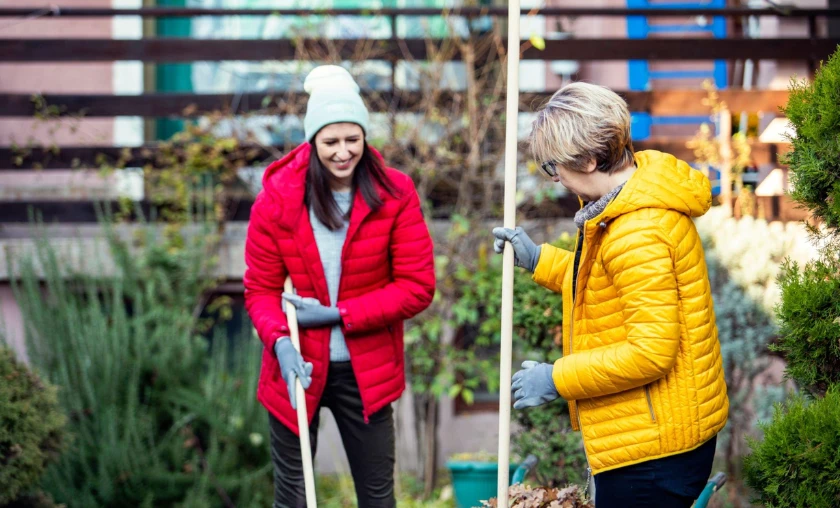
Gardening is a journey that evolves with the changing seasons. Each season brings unique tasks that contribute to the health and beauty of your garden. Spring, for instance, is a time of renewal and growth, requiring tasks like soil preparation, planting, and Mulching. Summer demands vigilant watering, deadheading, and pest control as your garden flourishes.
As fall arrives, focus on harvesting and preserving your hard-earned yields while preparing the garden for winter. This includes cleaning up fallen leaves, cutting back spent plants, and planting bulbs for a burst of spring color. And when winter blankets your garden in a serene hush, take the opportunity to plan for the upcoming year, study new gardening techniques, and start seeds indoors.
Winterization: Preparing Your Garden for Cold Months

Winter may be a time of rest for many plants, but your garden still requires thoughtful attention to ensure its well-being. Winterization is about providing protection against the harsh conditions that cold months bring.
Start by cleaning up your garden – remove dead plants, debris, and fallen leaves to minimize hiding places for pests and diseases. Apply a thick layer of mulch to insulate the soil and prevent extreme temperature fluctuations. Mulch also helps protect the roots of perennials and shrubs from freezing.
Consider wrapping vulnerable plants in burlap or other protective materials to shield them from cold winds and frost. And remember to disconnect and store irrigation systems to prevent freezing and damage.
Winter is also an excellent time to tackle garden infrastructure projects, like building raised beds, constructing trellises, or repairing fencing. By preparing in advance, you’ll be ready to hit the ground running when the next growing season arrives.
Tools & Equipment
Gardening Tools & EquipmentEvery gardener knows that a well-equipped toolkit is the secret to turning garden dreams into reality. We’re diving into the world of gardening tools and equipment – those trusty companions that help you dig, prune, and nurture with precision. Let’s explore the must-haves and discover how proper tool care keeps your garden arsenal in top-notch condition.
Must-Have Tools: Building Your Gardening Arsenal
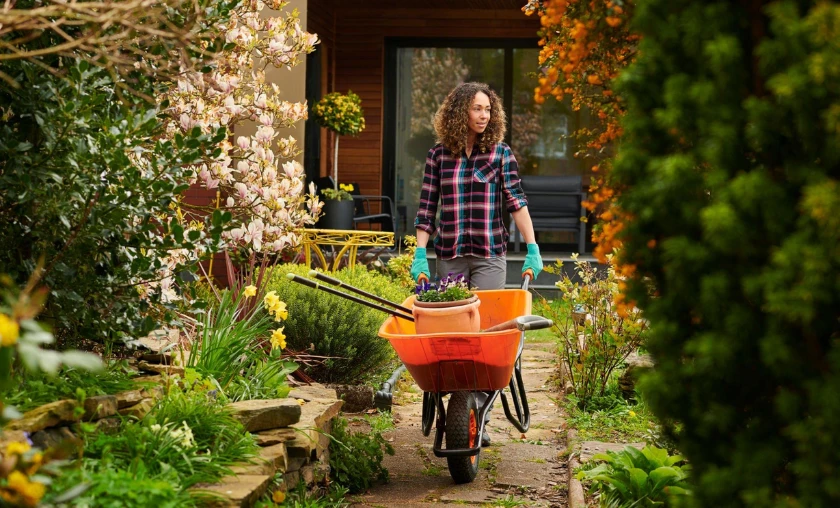
A gardener’s tools are like an artist’s brushes – they bring your creative vision to life. As you embark on your gardening journey, assembling a collection of essential tools is paramount. These tools become an extension of your hands, helping you plant, prune, and shape your garden with precision.
Among the must-haves are:
A watering can or hose ensures your plants stay hydrated, and a wheelbarrow aids in transporting heavy materials.
Specialized tools like hand trowels, cultivators, and weeders help you easily navigate intricate tasks. Consider investing in a hoe, a garden fork, and a long-handled lopper for larger spaces to tackle bigger projects efficiently.
Tool Maintenance: Extending the Lifespan of Your Equipment

A well-maintained tool is a faithful companion that stands the test of time. Proper tool care not only enhances their longevity but also improves their performance.
After each use:
Store your tools in a dry, organized space to prevent damage and make them easily accessible. Lubricate moving parts, such as hinges and springs, to ensure smooth operation. Regular maintenance saves you money in the long run & ensures that your tools are always ready to assist you.
Design & Aesthetics
Garden Design & AestheticsWe’re stepping into the world of garden design and aesthetics. Beyond the practicalities of planting, we’ll explore the power of layout, color, and ornamentation to shape a garden that’s not only functional but also a visual masterpiece. Join me as we uncover the secrets of creating a garden that delights the senses and reflects your unique style.
Beyond Function: Designing Your Garden’s Layout
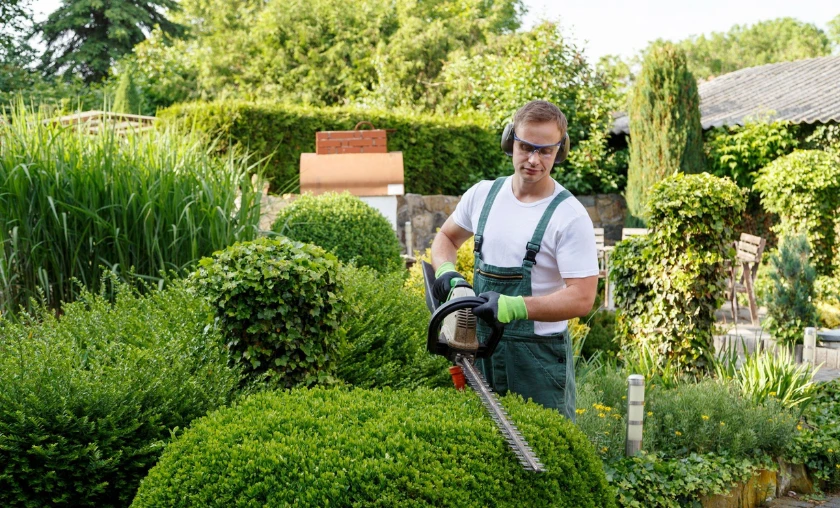
Your garden is a canvas waiting to be painted with lush colors and harmonious arrangements. Designing your garden layout involves considering not only the functionality of the space but also its visual appeal. Begin by determining the primary purpose of your garden – is it a peaceful retreat, a place for entertainment, or a thriving vegetable patch?
Pay attention to the principles of balance, rhythm, and unity. Balance involves distributing elements equally to create a harmonious feel, while rhythm introduces repetition to guide the eye and create a sense of movement. Unity ties everything together through consistent themes, colors, or shapes.
Mapping out pathways, focal points, and seating areas helps organize the space. Consider how different plants will interact with each other in terms of height, color, & texture. Remember, a well-designed garden is a place of harmony that soothes the soul and invites exploration.
Adding Visual Interest: Ornamental Elements & Accents

A garden isn’t just about plants; it’s also an opportunity to introduce captivating visual elements. Think of your garden as a story waiting to be told through statues, sculptures, birdbaths, or water features. These ornamental elements add depth, character, and intrigue to your garden’s narrative.
Texture and color are your artistic tools. Experiment with contrasting textures – rough against smooth, spiky beside soft – to create visual interest. Play with colors to evoke different moods – vibrant reds and oranges for energy, cool blues, and purples for tranquility.
Don’t overlook the power of hardscaping – pathways, walls, and structures that define and shape your garden’s personality. Integrate natural materials like stone or wood to blend seamlessly with the landscape.
Embracing Journey
Embracing the JourneyIt’s not just about planting and pruning; it’s about growth, patience, and the profound connection between you and the natural world. Join me as we explore the joys of nurturing life, embracing the rhythm of the seasons, and sowing the seeds of inspiration for future generations of green thumbs.
Patience & Progress: The Rewarding Path of a Gardener

Gardening is a reminder that nature operates on its own timeline. As you plant seeds and watch them sprout, as you nurture your plants from small shoots to mature specimens, you’re cultivating more than just a garden – you’re cultivating patience and perseverance. The garden teaches us that growth is gradual, progress is measured in seasons, and rewards come to those who tend to the journey.
Every stage of your garden’s evolution brings its own joys. The excitement of the first sprout, the pride of the first harvest, and the satisfaction of seeing your landscape flourish are moments that reward your efforts. Embrace the small victories and appreciate the lessons learned from setbacks. Gardening is a journey that unfolds one day at a time, teaching us to appreciate the beauty in both the destination and the path.
Growing Green Thumbs: Inspiring Future Gardeners

As you embark on your own gardening journey, you’re also sowing the seeds of inspiration for others. Whether you’re sharing tips with friends and neighbors, involving children in planting projects or simply allowing your garden to be seen, you’re fostering a connection to nature that’s increasingly valuable in our modern world.
Children who experience the magic of watching a tiny seed turn into a thriving plant often carry that sense of wonder into adulthood. By nurturing their curiosity and allowing them to dig, plant, and tend, you’re shaping future generations of gardeners who appreciate the beauty and complexity of the natural world.
Remember, your garden is a canvas for your creativity and a source of inspiration for those who witness its growth. As you embrace the journey and cultivate your green haven, you’re leaving a legacy that extends beyond the plants and enriches the lives of all who share in its beauty.
Conclusion
Congratulations! gardeners, on completing “The Basics of Gardening: Your Green Thumb Starter Guide.” As we wrap up this journey through knowledge and practice, remember that your newfound understanding is just the beginning of a lifelong connection with nature. Tending a garden nurtures more than just plants; it fosters your relationship with the earth, your patience, and your growth.
As you return to your garden equipped with insights on plants, planting techniques, and care, approach each task with intention. Nature’s surprises will enrich your experience, as the lessons a flourishing garden teaches are as diverse as its plants. Your journey as a gardener unfolds through seasons, experiences, and a deepening bond with the world.
Amidst tending to plants, you’re nurturing your own growth. Like life, gardening is a journey of learning and embracing the present. So, with a green thumb’s wisdom, continue to sow, nurture, and reap the rewards – not only in blooms and harvests but in the fulfillment of cultivating a natural sanctuary that mirrors your dreams and passion.
FAQs
What are the essential elements to consider when selecting a garden space?
When choosing a garden space, prioritize factors like sunlight, soil quality, and available space. These elements set the stage for a thriving garden, ensuring your plants receive the right conditions to flourish.
What’s the importance of pruning & deadheading in garden care?
Pruning and deadheading shape your plants, encourage new growth, and maintain a tidy appearance. Regularly removing spent flowers redirects energy to blooming, ensuring your garden remains vibrant throughout the season.
How can I prevent & manage common garden pests?
Integrated pest management (IPM) is key. Keep your garden clean, encourage beneficial insects, and choose pest-resistant plant varieties. Monitor for signs of infestations regularly, and use natural remedies or least-toxic solutions when necessary.
What are the key tasks in year-round garden maintenance?
Year-round gardening involves various tasks tailored to each season. From preparing soil and planting in spring to harvesting and preserving in summer, cleaning up and planting for spring in fall, and winterizing in winter, each season has its focus.
How can gardening nurture not just plants but also personal growth?
Gardening is a journey of patience, observation, and learning. As you tend to plants, you develop qualities like resilience, adaptability, and a deeper connection with nature. Your garden becomes a mirror of personal growth, teaching you to embrace life’s cycles and find beauty in every stage.
To read more similar articles, click here.
Thanks for visiting our Website. If you appreciate our work, kindly show us some support in our comments section. 🙂




